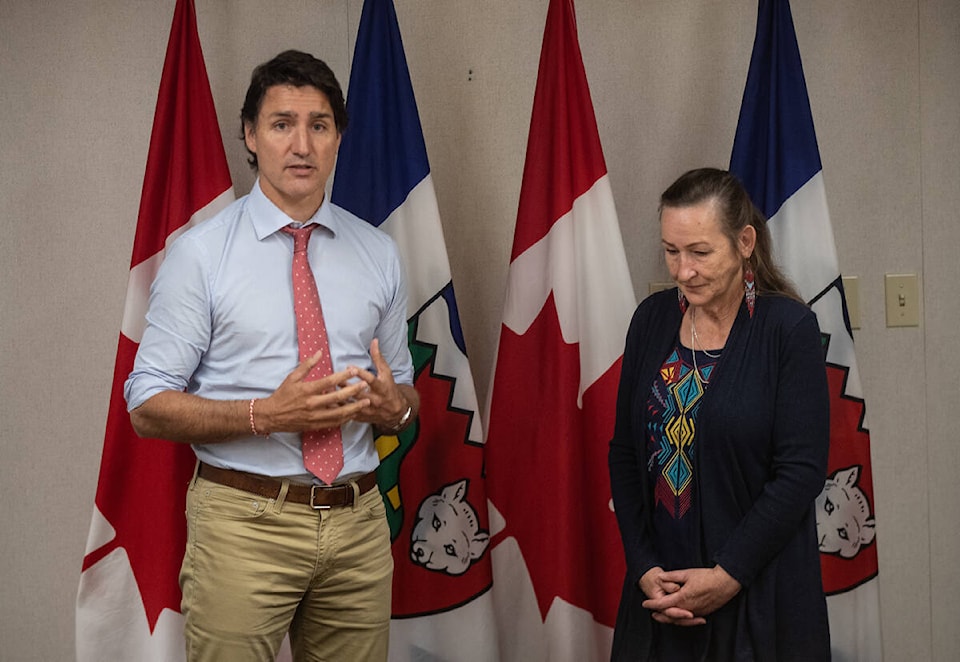Prime Minister Justin Trudeau and NWT Premier Caroline Cochrane have agreed to maintain contact as the NWT wildfire crisis continues.
A readout was distributed to media at 6 p.m. Aug. 26 following a meeting between the two elected leaders earlier in the day in Edmonton.
“Prime Minister Trudeau and Premier Cochrane discussed climate change and the ongoing wildfire situation in the Northwest Territories as well as what the Government of Canada is doing to help the people of the territory and all Canadians at this difficult time,” the readout states. “The Prime Minister reaffirmed the federal government’s commitment to help in battling the fires and supporting recovery and rebuilding efforts. The two leaders discussed shared efforts to control the wildfires and support residents who have been displaced, including the deployment of Canadian Armed Forces personnel, the Canadian Coast Guard, and firefighters from across the country. They also talked about plans for the safe return of evacuated residents when possible.
“The Prime Minister and the Premier spoke about the territory’s planned application under the federal Disaster Financial Assistance Arrangements (DFAA) program, and about investments in infrastructure, telecommunications, and climate change mitigation and adaptation. They committed to working together to expedite Employment Insurance (EI) supports for people impacted. The two leaders expressed their gratitude to first responders and the governments of Alberta and Manitoba for their support in sheltering evacuees.”
Disaster Financial Assistance Arrangements essentially means the federal government covers up to 90 per cent of eligible disaster mitigation costs. However, the design of the disaster mitigation and relief programs is the responsibility of the province or territory. In other words, the NWT is being asked to send Ottawa the bill. Advance payments can also be requested by a province or territory if the need arises.
A spokesperson for the Office of the President of the King’s Privy Council for Canada and Minister of Emergency Preparedness told NNSL the federal government is encouraging anyone out of work to apply for employment insurance right away, noting the normal requirement of submitting record of employment is being waived for evacuees.
“This has been an unprecedented wildfire season for communities right across the country, and we’re grateful to the firefighters, first responders, and emergency management professionals who have been working tirelessly to keep Canadians safe,” wrote press secretary Joanna Kanga Bissila Monique. “The tragic loss of four firefighters is a stark reminder of the dangerous conditions they face as they selflessly serve our communities, and our thoughts are, first and foremost, with their families and loved ones. In the past week alone, wildfires in British Columbia and the Northwest Territories have impacted thousands and forced entire communities to evacuate. Our thoughts remain with those who have lost their homes, their neighbourhoods and their livelihoods as a result of the fires.
“Despite these challenges, there are strong plans in place, and the Government of Canada is working closely with both domestic and international partners to mobilize resources, manage the fires and support Canadians. When Alberta, Nova Scotia, Quebec, Ontario, British Columbia, and the Northwest Territories requested federal assistance, we responded quickly. (Emergency Preparedness) Minister (Harjit) Sajjan remains in close contact with his provincial and territorial counterparts, and the Government Operations Centre continuously monitors new and evolving threats across the country," the readout states.
“Our first priority remains to keep people safe. Although we do not have an estimate cost for this disaster yet, we will continue to work closely with provincial and territorial governments to assess these costs and provide them with the support they will need through the response, recovery and reconstruction process.”
According to the federal government, the following expenses are eligible for reimbursement under the program:
- Evacuation, transportation, emergency food, shelter and clothing;
- Emergency provision of essential community services;
- Security measures including the removal of valuable assets and hazardous materials from a threatened area;
- Repairs to public buildings and related equipment;
- Repairs to public infrastructure such as roads and bridges;
- Removal of damaged structures constituting a threat to public safety;
- Restoration, replacement or repairs to an individual’s dwelling (principal residence only);
- Restoration, replacement or repairs to essential personal furnishings, appliances and clothing;
- Restoration of small businesses and farmsteads including buildings and equipment; and
- Costs of damage inspection, appraisal and clean up.
Examples of expenses that would NOT be eligible for cost-sharing:
- Repairs to a non-primary dwelling (e.g. cottage or ski chalet);
- Repairs that are eligible for reimbursement through insurance;
- Costs that are covered in whole or in part by another government program (e.g. production/crop insurance);
- Normal operating expenses of a government department or agency;
- Assistance to large businesses and crown corporations;
- Loss of income and economic recovery; and
- Forest firefighting, except where they pose a threat to built-up areas.
